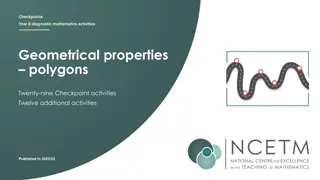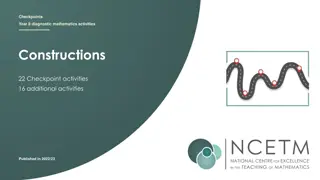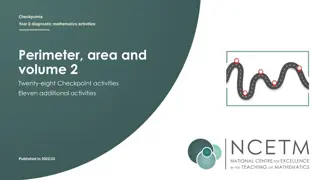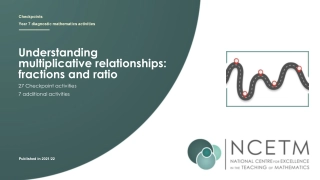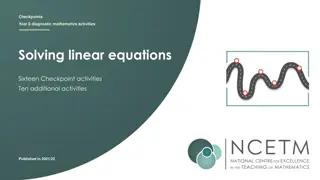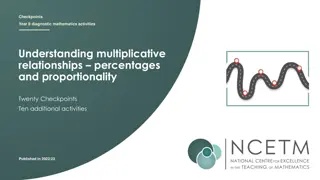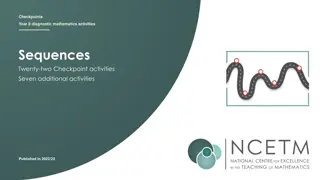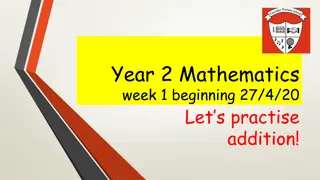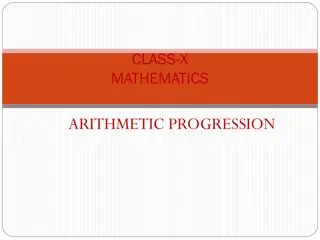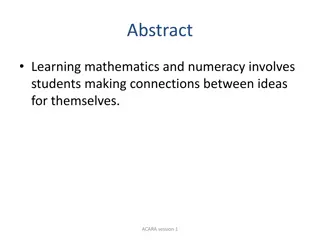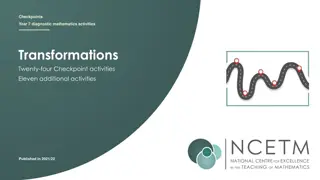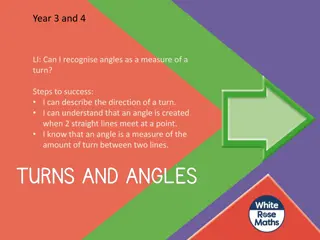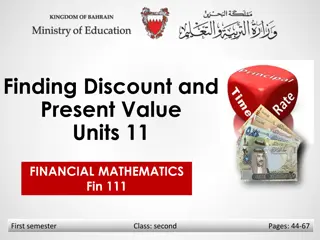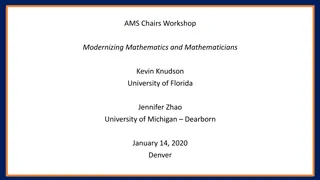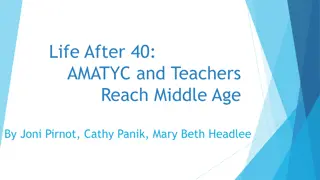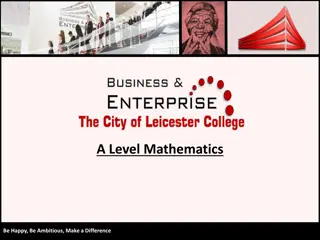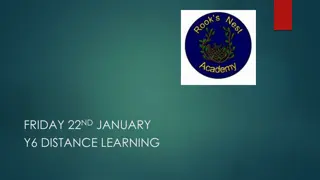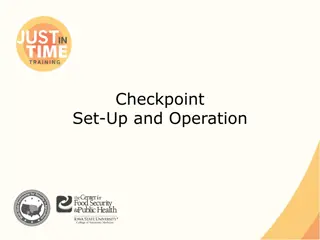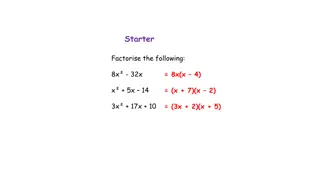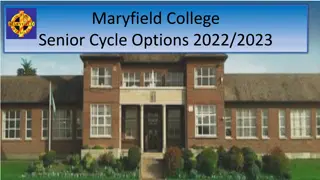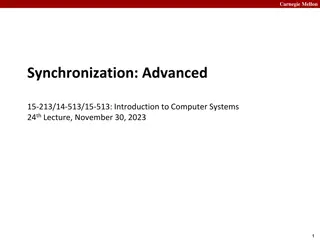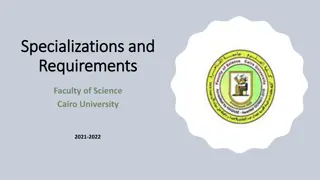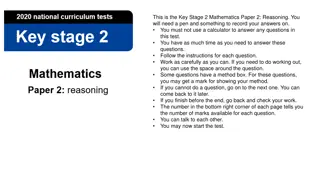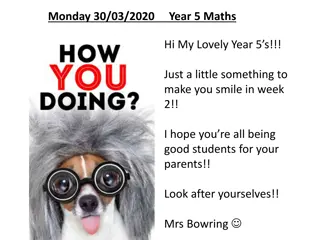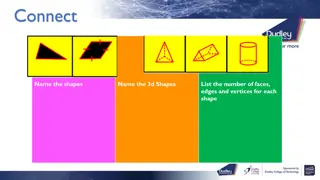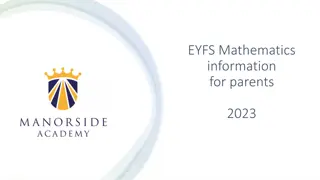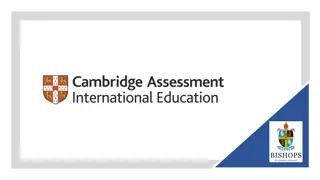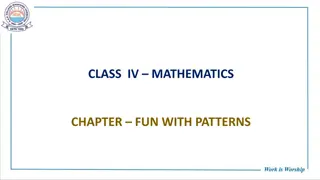Mathematics Checkpoints and Activities for Year 7 Students
Explore a series of mathematics checkpoints and activities designed for Year 7 students, focusing on place value, comparing representations, calculations, and understanding inequalities. Engage in tasks such as arranging digits, working with multiples of 3, and understanding the value of digits in decimals, measures, and integers. Dive into the world of numbers with interactive challenges and scenarios to enhance mathematical skills and knowledge.
Download Presentation

Please find below an Image/Link to download the presentation.
The content on the website is provided AS IS for your information and personal use only. It may not be sold, licensed, or shared on other websites without obtaining consent from the author. Download presentation by click this link. If you encounter any issues during the download, it is possible that the publisher has removed the file from their server.
E N D
Presentation Transcript
Checkpoints Year 7 diagnostic mathematics activities Place value Seven Checkpoint activities Seven additional activities Published in 2021/22
Checkpoints Checkpoint Underpins Code 1: Arranging digits 2: All the 3s 3: Comparing representations Understanding the value of digits in decimals, measures and integers 4: Calculations in colour 1.1.1* 5: Many-step calculations 6: Comparing lengths 7: Understanding inequalities *This three-digit code refers to the statement of knowledge, skills and understanding in the NCETM s Sample Key Stage 3 Curriculum Framework (see notes below for more information).
Understand place value in integers Checkpoints 1 2
Checkpoint 1: Arranging digits 9 7 6 0 8 Use the digit cards to create: a) the largest possible 5-digit number b) the smallest possible 5-digit number c) the 5-digit number that is closest to 60 000 d) the 5-digit number that is closest to 90 000 e) a number with 76 tens f) a number with 76 hundreds Using these cards, how many different 5-digit numbers can you create between 50 000 and 70 000? How do you know?
Checkpoint 2: All the 3s Write these numbers in digits: a) three hundred and thirty thousand and thirty-three b) thirty thousand three hundred and thirty-three c) three hundred thousand and thirty-three d) thirty three thousand and thirty-three e) three hundred and thirty thousand, three hundred and thirty-three f) thirty three thousand three hundred and thirty-three g) three hundred and thirty three thousand three hundred and thirty-three h) three million and thirty-three Write your set of numbers in ascending order. Can you think of any other numbers that use only the digits 3 and 0? Where would they fit in your set?
Understand place value in decimals Checkpoints 3 5
Checkpoint 3: Comparing representations Amina, Beth and Cameron each use a representation to show a different number. Cameron Beth Amina ? ??s ? ? ???s ????s 100s 10s 1s a) What number is represented by each student? b) What is the same and what is different about their numbers? c) Can you write a calculation using one or more of the operations from the box on the right to connect their numbers? Why or why not? 10 10 100 100 1000 1000 What would you need to change to write a calculation connecting all three numbers? Is there more than one way to do this?
Checkpoint 4: Calculations in colour In these calculations, coloured dots have replaced digits. Describe how the dots and decimal points will be arranged after the calculation has been carried out. What mathematical operations will result in the digits making these movements? Create your own questions using coloured dots. Can you think of four different examples showing 100? How about 100?
Checkpoint 5: Many-step calculations 9.81 10 = 98.1 This is a one-step calculation to move from 9.81 to 98.1 9.81 100 10 = 98.1 This is a two-step calculation to move from 9.81 to 98.1 a) Write at least two three-step calculations to move from 9.81 to 98.1 b) Write as many four-step calculations to move from 9.81 to 98.1 as you can Can you write a 10-step calculation to get from 9.81 to 98.1?
Understand place value in the context of measure Checkpoint 6
Checkpoint 6: Comparing lengths Fill in the blanks. a) cm > 2 m b) m < 400 cm e) mm > 20 cm > m f) mm < 40 cm < m c) 200 cm < m g) 20 cm > mm > m d) 4 m > cm h) 40 km < m < cm km < m < cm < mm
Order and compare numbers and measures using <, >, = Checkpoint 7
Checkpoint 7: Understanding inequalities In each set of numbers, which is the bigger value? Write a statement using < or > to compare your values. d) a) 1 900 fourteen thousand 0.4 0.09 e) b) 109 000 140 000 1.09 1.4 f) c) 190 000 1.4 million 0.04 0.019 Write your own inequalities statements using the digits 0, 1, 4 and 9. Can you write a statement that no one else will have thought of?
Additional activities Activities A G
Activity A: Partition table The number 3 254 can be written as 3 1 000 + 2 100 + 5 10 + 4 1. Complete the table so that each row has a number and its partitioned form. a) 32 054 b) 3 100 000 + 2 100 + 5 10 + 4 1 c) 3 100 000 + 2 1 000 + 5 100 + 4 1 d) 3 200 540 e) a 10 000 + b 100 + c 10 Given that 100 = 102 and 100 = 103, can you rewrite the partitioned numbers using powers?
Activity B: Strategising with place value William and Vicky take it in turns to pick a digit card from 0 9 and write that number anywhere on the grid. The winner is the person with the biggest number at the end. Vicky picks a 4 next. Where should she place it on the grid to stand the best chance of winning? Ten Thousands Hundreds Tens Ones thousands William 4 9 Vicky 2 9 How would Vicky s strategy change if the rules changed to be: The winner is closest to 5 000? The winner is the smallest number?
Activity C: Comparing place value in integers Use <, > or = to complete these statements. a) 310 31 tens 301 hundreds d) 31 thousands 13 hundreds e) 120 000 ones b) 120tens 130 hundreds f) 12 hundreds and 35 tens 1 235 c) 5 005 505 tens Where you used < or >, change one number so that you could use = instead. Is there more than one way to do this?
Activity D: Non-hundred squares a) What value is shaded? b) How could this be true? A B The whole of this square is worth 1000. How much is the green section worth? > The whole of this square is worth 10. How much is the orange section worth? What might squares A and B be worth? Is there more than one possible answer? Using pairs of hundred squares, can you write: A statement where two squares look different but are equal? A statement where two squares look the same but are not equal?
Activity E: Comparing place value in decimals Use <, > or = to complete these statements. 0.9 a) 3.1 d) 9 hundredths 31 tenths 12 hundredths e) 0.012 b) 120 thousandths 120 hundredths f) 12 tenths and 35 hundredths 1.235 c) 50.05 505 tenths Where you used < or >, change one number so that you could use = instead. Is there more than one way to do this?
Activity F: Place value with 4.32 a) What is the value of the bold red digit in each number? 43.2 4.32 4320 4.32 0.0432 4.32 432 4.32 0.00432 4.32 0.432 4.32 b) What do you notice about each pair of numbers? c) Can you write a calculation involving both numbers? The first one has been done for you. 0.432 10 = 4.32 Can you write all of your calculations another way?
Activity G: True or false? Which of these statements are correct? How do you know? a) 100 0.7 = 7 e) 10 0.7 = 0.07 100 b) 0.70 = 0.7 x 10 f) 0.70 < 0.07 100 c) 0.70 > 0.7 g) 0.7 10 < 70 100 d) 70 100 < 0.07 10 h) 0.07 10 > 0.7 100 Change one thing about the statements that are incorrect to make them correct. Is there more than one way to do this?


